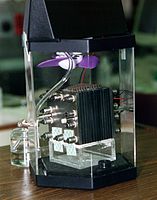
Photo from wikipedia
Ethanol-based E5 and E10 fuels have extensively been used as automotive fuels in gasoline engines. However, especially when contaminated, these fuels can exhibit corrosion effects on some engine construction parts… Click to show full abstract
Ethanol-based E5 and E10 fuels have extensively been used as automotive fuels in gasoline engines. However, especially when contaminated, these fuels can exhibit corrosion effects on some engine construction parts such as mild steel. Thus, the study of mild steel corrosion resistance has become of the utmost importance. Electrochemical methods such as electrochemical impedance spectroscopy (EIS) and polarization characteristics measurements (Tafel scan—TS) were proven to be very valuable in studying the mild steel corrosion behavior in ethanol–gasoline blends (EGBs). However, the use of these methods was, so far, very limited for low-ethanol-content EGBs such as E5 and E10 due to their low conductivity. In this study, we present modified EIS and TS corrosion measurements based on the use of tetrabutylammonium tetrafluoroborate (TBATFB) at 500 mg/L as a supporting electrolyte. This modification led to an increase in the contaminated E5 and E10 fuels’ conductivity, which allowed us to successfully perform the electrochemical corrosion tests. The corrosion current densities were determined to be 1.5 × 10–3 and 1.5 × 10–2 μA/cm2 for the tested E5 and E10 fuels, respectively. These modified methods present a significant extension of an electrochemical testing apparatus for steel corrosion studies in EGBs. They can allow one to obtain instantaneous information about the occurring corrosion process and, thus, estimate the materials’ lifetime in corrosive environments and potentially help to prevent corrosion.
Journal Title: ACS Omega
Year Published: 2021
Link to full text (if available)
Share on Social Media: Sign Up to like & get
recommendations!